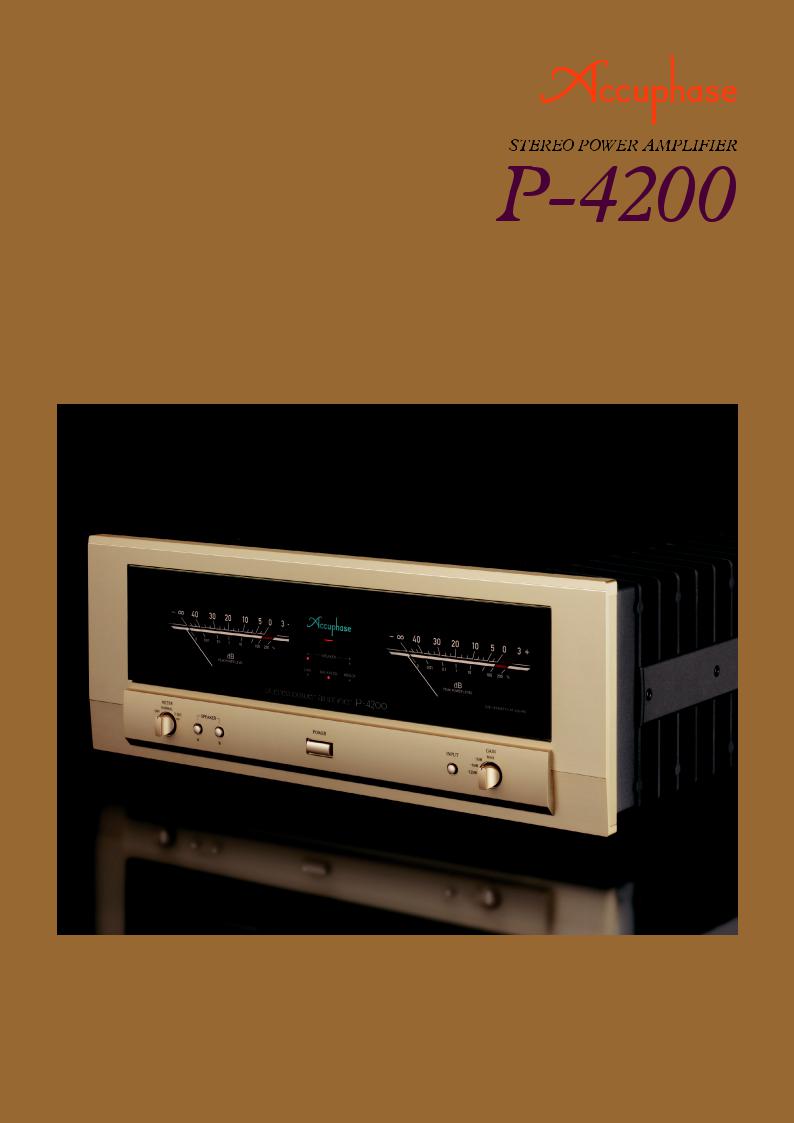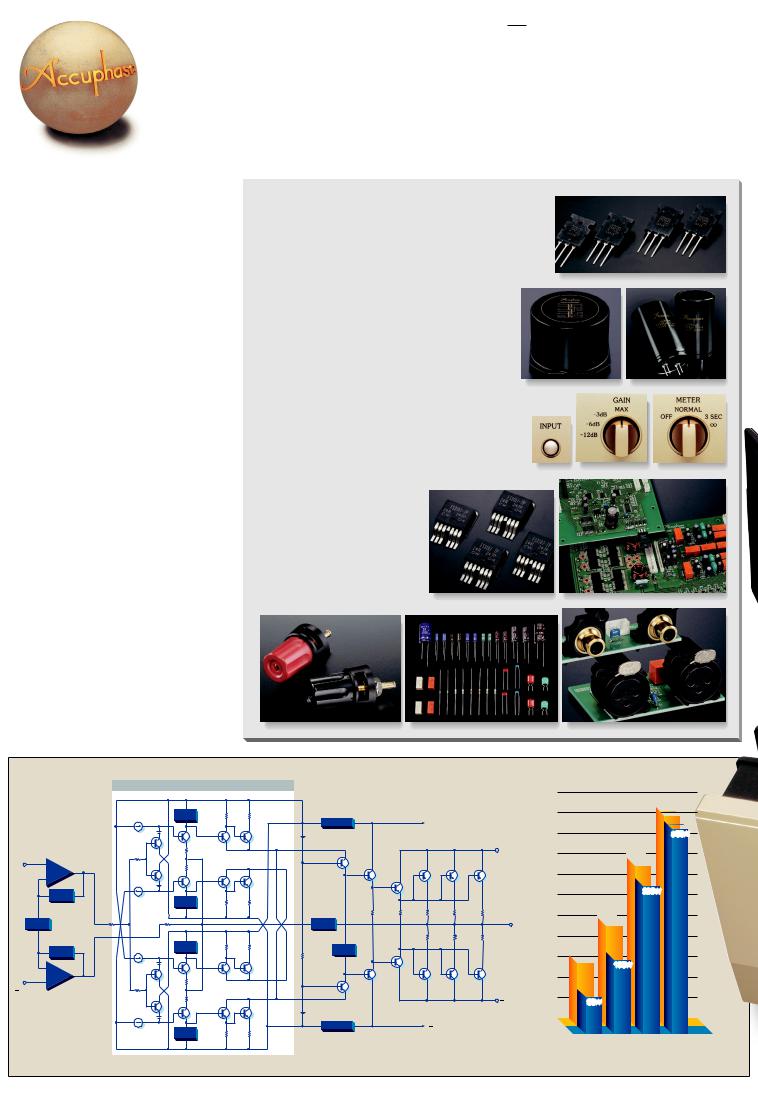Accuphase P-4200 User Manual

● Output stage with triple parallel push-pull configuration for each channel delivers high power down to very low impedance loads ● Instrumentation amplifier principle used in input stage ● MCS+ circuit and current feedback topology in amplification stage ●Bridged connection mode allows upgrading to monophonic amplifier ● Strong power supply with massive high-efficiency toroidal transformer and large filtering capacitors ● 4-stage gain control

Stereo power amplifier with impeccable performance Instrumentation amplifier principle in amplification stage allows fully balanced signal paths. Further refined MCS+ and current feedback topology assure excellent sound, with outstanding S/N ratio and excellent performance in all other aspects. A hefty power supply and power transistors arranged in a triple parallel push-pull configuration deliver 500 watts/ch (music signals) into an ultra-low 1-ohm load. Output stage with further lowered impedance results in a damping factor of 500.
Ever since its founding in 1972, Accuphase has designed its power amplifiers for optimal speaker drive, capturing the high-end market with a succession of highly regarded models that became legend. The commemorative model A-200 released on the occasion of the company’s 40th anniversary demonstrated Accuphase’s mastery of power amplifier technology. It stands at the pinnacle of its field and has been widely lauded as a history-making achievement both in terms of performance and sonic excellence. The Stereo Power Amplifier P-4200 incorporates the outstanding design technology of the A-200. Based on the P-4100, it represents a full model change with further enhanced overall circuitry. Latest instrumentation amplifier topology is implemented in the entire configuration of the P-4200, allowing not only fully balanced signal paths from the inputs onwards, but also the realization of a gain control that effectively minimizes residual noise. The power amplifier section features another Accuphase specialty, namely the MCS+ topology in combination with current feedback, ensuring outstanding S/N ratio and superior electrical performance characteristics. The output stage for each channel uses three pairs of high-power transistors with a Pc rating of 220 watts, arranged in a parallel push-pull configuration. This ensures low output impedance. Stable operation is achieved by mounting the devices to massive heat sinks on both sides of the chassis, for efficient dissipation of thermal energy. As demonstrated by the power rating of 500 watts per channel into 1 ohm (music signals only), the P-4200 can easily drive speakers with very low impedance, and speakers with uneven impedance curves are also handled with aplomb. Using the P-4200 in bridged mode creates a monophonic amplifier with even more impressive power output capability. This kind of performance is sustained by a power supply section with a large toroidal transformer whose efficiency has been further increased compared to the P-4100, and two large 47,000 µF filtering capacitors selected for ultimate sound quality and reflecting know-how gained with the A-200.
The output circuitry also benefits from the latest technology advances. Output relays have been replaced by MOS-FET switches that combine excellent reliability with highly pure amplification. Redesigned output coils and other features result in lower energy losses and allow a drastic improvement of the damping factor to 500. This rating not only points towards an extremely wide power bandwidth, it also means that the degree of coupling between loudspeakers and amplifier has been tightened even further, resulting in music playback of impressive fidelity.
■Power modules with high-power transistors in triple parallel push-pull arrangement deliver linear power of 500 watts per channel into 1 ohm (music signals only), 360 watts into 2 ohms, 180 watts into 4 ohms, or 90 watts into 8 ohms.
■Large, high-efficiency toroidal transformer and two
47,000 µF aluminum electrolytic capacitors selected for |
High-power transistors used in output stage |
best sonic performance. |
|
■Output stage with further lowered impedance |
|
realizes damping factor of 500. |
|
■Bridging allows upgrade to monophonic amplifier |
|
with even higher power, delivering 1,000 watts |
|
into 2 ohms (music signals only), 720 watts into 4 |
|
ohms, or 360 watts into 8 ohms.
■Input selector button on front panel allows Toroidal power transformer |
Filtering capacitors |
switching between Line and Balanced signals. |
|
■4-stage gain selector (MAX, -3 dB, -6 dB, -12 dB) also minimizes residual noise.
■Large analog power meters with on/off switch
and peak hold function (3 seconds/infinite). |
Input selector button Gain selector |
Meter selector |
|
■Semiconductor (MOS-FET) switches used for protection circuitry prevent contact
problems and ensure long-term reliability. Eliminating mechanical contacts from signal path also further enhances sound quality.
■Two sets of oversize speaker terminals also accept Y lugs.
MOS-FET switches |
Assembly with meter and protection circuitry etc. |
Large speaker terminals |
Parts selected for high sound quality and reliability |
Assembly with line and balanced input connectors |
Signal input stage |
|
Power amplifier stage |
|
MCS+ Multiple Circuit Summing |
|
|
|
|
|
550 |
|
|
|
|
||
|
|
|
|
|
|
|
|
|
|
|
|
|
|
|
|
|
|
|
|
|
|
|
|
|
|
512W |
|
|
Bias |
|
|
|
|
|
|
|
500 |
|
|
|
|
|
stabilizer |
|
|
|
|
|
|
|
|
|
|
|
|
|
circuit |
|
|
REGULATOR |
|
+ B1 |
|
|
|
|
|
|
|
|
|
|
|
|
|
|
|
|
|
|
|
||
|
Q1 |
|
|
|
|
|
|
|
450 |
|
|
|
500W |
|
|
|
|
|
|
|
|
|
|
|
|
|
|
|
Q5 |
Q9 |
Q13 |
|
|
|
+ B2 |
|
|
|
|
|
|
|
|
|
|
|
|
|
|
|
|
|
|||
+ INPUT |
|
|
|
Q17 |
|
|
|
|
400 |
|
389W |
|
|
|
|
|
|
Q19 |
Q23 |
Q25 |
Q27 |
|
|
|
|
|
|
|
Q7 |
Q11 |
Q15 |
|
350 |
|
|
|
|
||||
|
Q21 |
|
|
|
(W) |
|
|
|
|
||||
Q3 |
|
|
|
|
|
300 |
|
|
|
|
|||
NETWORK |
Bias |
|
|
|
|
|
|
power |
|
|
360W |
|
|
NFB |
|
|
|
|
|
|
|
|
|
|
|
|
|
|
stabilizer |
|
|
|
|
|
|
Output |
|
|
|
|
|
|
circuit |
|
|
|
|
|
|
|
|
|
|
|
|
GAIN CONTROL |
|
|
|
NFB |
|
|
OUTPUT |
250 |
243W |
|
|
||
CIRCUIT |
|
|
|
NETWORK |
|
|
|
|
|
|
|
|
|
|
|
|
|
|
|
|
|
|
200 |
|
|
|
|
|
Bias |
|
|
Bias |
|
|
|
|
|
|
|
|
|
NFB |
stabilizer |
|
|
|
|
|
|
|
|
|
|
|
|
circuit |
|
|
stabilizer |
|
|
|
|
|
152W |
|
|
|
|
NETWORK |
|
|
|
circuit |
|
|
|
|
150 |
|
|
|
|
|
|
|
|
|
|
|
|
|
|
|
|
|
|
|
Q2 |
|
|
Q22 |
|
|
|
|
|
|
180W |
|
|
|
|
|
|
|
|
|
|
|
|
|
|||
|
Q6 |
Q10 |
Q14 |
Q20 |
Q24 |
Q26 |
Q28 |
|
100 |
|
|
|
|
|
|
|
|
|
|
|
|
|
|||||
INPUT |
|
|
|
Q18 |
|
|
|
|
|
|
|
|
|
|
|
|
|
|
|
|
|
50 |
|
|
|
|
|
|
|
|
|
|
|
|
B2 |
|
90W |
|
|
|
|
|
Q8 |
Q12 |
Q16 |
|
|
|
|
|
|
|
|
||
|
|
|
|
|
|
|
|
|
|
||||
|
Q4 |
|
|
|
|
|
|
|
|
|
|
|
|
|
|
|
|
REGULATOR |
|
B1 |
Max. output power |
|
|
|
|
||
|
Bias |
|
|
|
Rated output power |
|
|
|
|
||||
|
|
|
|
|
|
|
|
|
|
||||
|
stabilizer |
|
|
|
|
|
|
|
|
|
|||
|
circuit |
|
|
|
|
|
|
|
|
8Ω |
4Ω |
2Ω |
1Ω |
|
|
|
|
|
|
|
|
|
|
||||
Impedance (Ohms)
Figure 1 Circuit diagram of amplifier section (one channel) |
Figure 2 Output power characteristics |
